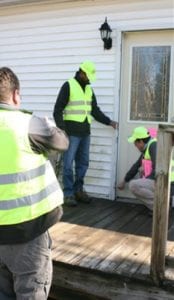DART – Disaster Assistance Response Team

The purpose of a Disaster Assistance Response Team (DART) is to assist communities handle floodplain management responsibilities after a natural disaster. DART members are all skilled floodplain managers representing many sectors. DART members have disaster response experience and are fully trained. The DART can assist the local floodplain manager by conducting flood damage reconnaissance, high-water mark data collection, substantial damage estimates, training, and guidance on mitigation actions. The intent of the DART is to help communities expedite response and recovery tasks immediately after the disaster.

The DART Board
Background
- An introductory presentation providing a summary overview of the DART program.
- A short one-page handout with a summary of DARTs and FAQs
Disaster Assistance Response Team Playbook
- A complete guidebook providing step-by-step guidance to assess state mutual aid capabilities and start a Disaster Assistance Response Team (DART). The playbook appendix includes resources and templates to help in the DART formation process.
Training
Emergency Assistance Compact (EMAC) Training Center
- Provides a wide variety of training resources and tools for EMAC administration and deployment.
Templates
Sample Agreement Between State and Local, Non-Governmental or Tribal Organizations
- A sample mutual aid agreement (template) provided by the National Emergency Management Agency (NEMA) for use with the Emergency Management Assistance Compact (EMAC). This template provides an instrument that can be employed between states and non-state resources to specify the financial and legal responsibilities of each party.
DART Sample Community Request Letter
- A letter template which can be used by communities to request DART assistance through the ASFPM Chapter.
- A short one-page summary listing DART expectations of ASFPM, Chapters, DART Volunteers, and the Host Community.
DART Volunteer Waiver Template
- A Release of Liability template between the DART Volunteer and the ASFPM Chapter. For use in states without well-defined mutual aid agreements or “Good Samaritan” protection.
- A suggested list of equipment needs for both the DART Team and individual volunteers.
Disaster Assistance Response Team (DART) Membership Profile Questionnaire
- A one-page DART Volunteer application form for use by ASFPM Chapters. The form provides background information on the volunteer as well as emergency contact information (edited from the Illinois RAFT Team).
Start a DART! A Checklist of Actions
- A checklist providing the step-by-step actions an ASFPM Chapter would need to form a DART. This checklist is taken from the DART Playbook.
- A Step-by-step summary of the process and logistics needed to deploy a DART. Includes pre-deployment logistics, coordination with the requesting community, on-site inspections, and post-deployment strategies (taken from the DART Playbook).
- A fill-in-the-blank Memorandum of Understanding template between the ASFPM Chapter and the State Emergency Management Agency. The template is edited from the State of Florida MOU. This example MOU may need to be modified to meet each state’s individual mutual aid framework.
Resources
Disaster Assistance Response Team (DART) Workbook
- A workbook developed for ASFPM training on forming a DART. The workbook provides an easy-to-use format and templates for states to assess their mutual aid capabilities and create a DART.
An Analysis of EMAC Capabilities for Private Sector and Volunteer Resource Coordination
- A National Emergency Management Association (NEMA) report capturing state EMAC experiences with a primary emphasis on the using the EMAC process to deploy private sector and volunteer resources to states with specific needs requested through EMAC.
FEMA Mutual Aid Tracking Portal
- An easy-to-use map based portal providing helpful summaries of each state’s EMAC and IMAC regulations.
- Part of the FEMA Mutual Aid Tracking Portal, these state based fact sheets provide helpful summaries of each state’s mutual laws and capabilities.
Illinois Rapid Assistance Flood Team (RAFT) Guidance
- The State of Illinois Rapid Assistance Flood Team (RAFT) Guidebook. Provides excellent summaries and useful templates.
Florida Post-Disaster Toolkit for Floodplain Administrators
- The State of Florida Post Disaster Toolkit is largely a substantial damage guidebook but also provides excellent guidance on using mutual aid for assistance. A good booklet for those states desiring to develop a pre-event substantial damage plan.
Substantial Improvement/Substantial Damage Desk Reference
- FEMA’s Substantial Damage Desk Reference (FEMA P-758). The primary reference for substantial damage and substantial improvement guidance.
Louisiana Floodplain Management Association Disaster Response Team (DRT) Program
- A summary overview of the State of Louisiana Disaster Response Team. Provides a good explanation of the LFMA DRT operations and logistics.
Flood Warning & Response Case Study: Oklahoma’s Disaster Response Team
- A fact sheet providing a short written summary of the State of Oklahoma’s Disaster Response Team.
